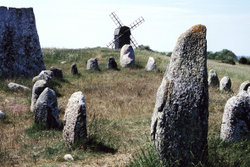Agricultural landscape of southern Öland
| Agricultural landscape of southern Öland | |
|---|---|
|
UNESCO world heritage |
|

|
|
| The burial ground near Gettlinge with a ship setting |
|
| National territory: |
|
| Type: | Culture |
| Criteria : | (iv), (v) |
| Reference No .: | 968 |
| UNESCO region : | Europe and North America |
| History of enrollment | |
| Enrollment: | 2000 (session 24) |
The agricultural landscape of southern Öland has been a Swedish World Heritage Site since 2000 .
Öland is the fourth largest island in the Baltic Sea . About a third of the island, approximately 560 square kilometers, is a World Heritage Site, which includes fields, pasture land, villages, refuges and bodies of water. Agricultural use of the island began around 3000 BC. And the land use is largely the same today as it was in the Stone Age due to the natural geographic framework .
During the Middle Ages , the land was divided into village grounds, arable land and meadows, and pasture land. Row villages emerged on the village grounds, which still shape the landscape today with their simple, ox-blood-colored wooden houses. Arable land and meadows were farmed together, with each farm having a share in each field. The village meadows, which were about five to six times the size of the arable land, served as grazing land for the domestic animals and were used for winter fodder. The fields and meadows were protected from the grazing herds of cattle and wild animals by stone walls. It was not until the 19th century that the common arable land and meadows were divided up between the farms. Low stone walls, which are so typical of the landscape today, separated the new fields and meadows.
The land outside the stone walls was pastureland, on which the sheep and cattle herds of the villages grazed, but also where herds of semi-wild horses roamed. It is mainly heathland or Alvar ( Stora Alvaret ), which takes up almost half of the area in the world cultural heritage (260 km²). The thin layer of soil on the heather is exposed to both extreme drought and flooding, which makes the flora unique. The flat coastal pastures, the lake meadows ( sjömarker ), in turn, are an important bird reserve, which is looked after by the bird sanctuary in the Ottenby nature reserve to the south . The pastureland was also divided up as part of the land reform in the 19th century and the plots were separated from each other by stone walls.
In this historic agricultural landscape there are numerous testimonies from the Stone, Bronze and Iron Ages: passage graves from the Stone Age, burial mounds from the Bronze Age, refuges, house foundations and burial fields from the older Iron Age indicate that this landscape was inhabited by people for several thousand years was used.
In the justification for the recognition as a world cultural heritage it becomes clear that it is precisely the character as a millennia-old cultural landscape that led to the world heritage status:
- “Today's landscape in southern Öland is shaped as much by its long cultural history as it is by geological and topographical conditions. The farming landscape ( odlingslandskap ) of southern Öland is a unique example of how humans use the multiform landscape (...) in an optimal way. "
Web links
Individual evidence
- ↑ Världsarvet Södra Ölands odlingslandskap ( Memento from August 22, 2006 in the Internet Archive )
Coordinates: 56 ° 28 ' N , 16 ° 33' E
